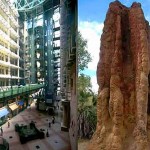Apr02
Andrea Meyer
Point: Get quick wins by encouraging small experiments throughout the organization. They’re fast, inexpensive, and reduce the fear of failure.
Story: One of the biggest obstacles to innovation is fear of failure. Rarely do people want to bet their careers or companies on what might — or might not — be the next big thing. But fear of failure becomes a self-imposed obstacle to success.
As Amazon’s CEO Jeff Bezos says, “Innovation is part and parcel with going down blind alleys. You can’t have one without the other. But every once in a while, you go down an alley and it opens up into this huge, broad avenue. And that’s so satisfying and, from a shareholder’s point of view, so successful, that it makes going down blind alleys worthwhile.”
The key twist isn’t to avoid failure but to avoid high costs from failure. To reduce those costs, institute and encourage ongoing little experiments throughout your company. For example, Google does this by testing more than 5000 software changes a year. Amazon does it by continuous A/B testing. And CEO Scott Cook made experiments common practice at Intuit. In Cook’s experience, 89% of experiments don’t lead to a breakthrough or even to an improvement, but that doesn’t make them a “failure” — the experiments simply provide data on what doesn’t work.
These little bets cost little in terms of time and money. They don’t require weeks of planning; rather, they’re tweaks to an idea that can lead to eventual, substantive breakthroughs. Ever hear of a company called Odeo? Most people haven’t, because Odeo was a small podcasting company of little distinction until its CEO, Evan Williams, gave employee Jack Dorsey two weeks to develop his idea of a short messaging system. That quick prototype developed into Twitter.
Action
- Don’t use uncertainty of success as a filter — the more you don’t know about your chances, the more you can learn by trying.
- Do consider how you might inexpensively look down a possible avenue to see where it leads. You might use a A/B testing, co-innovation with a lead customer, or a quick minimum-viable prototype.
- Test fast, test often, but pay attention to the results, especially if the unexpected happens.
- Learn what you can from any failures — not just that the idea failed, but why it failed and what it says about your customers, your markets, or your business environment.
- Use each test of a new avenue to scout for other avenues. Even a blind alley can have a side-passage that leads somewhere wondrous.
For more information:
Dave Gray, The Connected Company
Bloomberg BusinessWeek, “Jeff Bezos: ‘Blind-Alley’ Explorer.”
Peter Sims, Little Bets and “What are Little Bets?“
Growth, How-to, Innovation, New Product Development, Opportunity, Productivity
Mar06
Andrea Meyer
Point: If you’re stuck on how to solve a problem, see if nature has already solved that problem.
Story: Nature has already solved many challenges; the best solutions have survived and improved through evolution.
Consider this example: termite mounds such as those of the Macrotermes michaelseni exist in African environments where the external temperature varies from 35°F at night to 104°F during the day. The living areas inside the termite mounds, however, maintain a constant internal temperature within one degree of 87 °F, day and night. Millions of years of evolution perfected the termites’ construction habits so that their mounds’ passive solar design and networks of air conduits create a self-cooling ventilation system.
How can humans put this termite-inspired solution to use? Architect Mick Pearce collaborated with engineers at Arup Associates to design a mid-rise building in Harare, Zimbabwe, called Eastgate, that has no air-conditioning, yet stays cool. The Eastgate Center is the largest office and shopping complex in Zimbabwe, but it uses only only 10% of the energy of a conventional building its size. Not only is this good for the environment, but it lowers costs for building occupants. Eastgate occupants pay 20% lower rents than do occupants in nearby buildings pay.
How did Pearce design this building? He looked a 3D digital scans of termite mounds, manipulating them in computer models to understand how the tunnel system works to exchange gases and regulate temperature and humidity. It turns out that the termite mounds operate on a system of convection currents that draw air at the lower part of the mound down to the bottom and then exhaust heated air to the top. The termites open and close ducts by digging new vents and plugging up old ones. At Eastgate, Pearce installed electronically-controlled fans on the first floor to suck in outside air and then push it up along a central spine, venting it through chimneys at the top.
computer models to understand how the tunnel system works to exchange gases and regulate temperature and humidity. It turns out that the termite mounds operate on a system of convection currents that draw air at the lower part of the mound down to the bottom and then exhaust heated air to the top. The termites open and close ducts by digging new vents and plugging up old ones. At Eastgate, Pearce installed electronically-controlled fans on the first floor to suck in outside air and then push it up along a central spine, venting it through chimneys at the top.
Action
- If you have a problem to solve, think about the plants and animals that may have had the similar problem. Look to sites like AskNature.org or the Biomimicry 3.8 Institute
- Study nature for inspirations and ideas that you can adapt
- If you don’t have time to do this yourself, consider holding an innovation contest with InnoCentive, NineSigma, or Yet2.com to solicit ideas from biologists, oceanographers, etc. who could apply knowledge from the biological world to tackle your problem.
Sources:
Janine Beyrus, Biomimicry: Innovation Inspired by Nature, chapter 1
Biomimicry 3.8 Institute
Abigail Doan, Green Building in Zimbabwe Modeled After Termite Mounds | Inhabitat – Sustainable Design Innovation, Eco Architecture, Green Building
Case study, How-to, Innovation
Feb07
Andrea Meyer
Point: Design physical spaces for unplanned collaborations that spark creativity.
Story: One place to look for advice on designing physical spaces for creativity and collaboration is  Stanford’s design school, the birthplace of design thinking as we know it today. (The term dates back to Herbert Simon’s 1969 book, The Sciences of the Artificial and was further explained by Robert McKim’s book, Experiences in Visual Thinking, but it was Stanford’s Rolf Faste and David Kelley who popularized the term and applied it to business.)
Stanford’s design school, the birthplace of design thinking as we know it today. (The term dates back to Herbert Simon’s 1969 book, The Sciences of the Artificial and was further explained by Robert McKim’s book, Experiences in Visual Thinking, but it was Stanford’s Rolf Faste and David Kelley who popularized the term and applied it to business.)
Now, Scott Doorley and Scott Witthoft, co-directors of the Environments Collaborative at the d.school, have written a book, Make Space: How to Set the Stage for Creative Collaboration that’s full of advice and case studies of these creative spaces.
David Kelley, founder of IDEO and of the d.school, writes in the book’s forward: “Regardless of whether it’s a classroom or the offices of a billion-dollar company, space is something to think of as an instrument for innovation and collaboration. Space is a valuable tool that can help you create deep and meaningful collaborations in your work and life.”
Example: Pixar
A real-life example of a physical space that encourages creative collaboration is the building that houses Pixar, the computer animation studio that created innovative, Academy-award-winning blockbuster films like Toy Story, Monsters and Finding Nemo.
As Walter Isaacson writes in his biography of Steve Jobs, Jobs designed the Pixar building to promote encounters and unplanned collaborations. “If a building doesn’t encourage that, you’ll lose a lot of innovation and magic that’s sparked by serendipity,” Jobs said. “So we designed the building to make people get out of their offices and mingle in the central atrium with people they might not otherwise see.” The front doors and main stairs and corridors all lead to a central atrium, where a cafe and employee mailboxes are located as well.
John Lasseter, Chief Creative Officer at Pixar, confirmed the success of the building’s layout: “Steve’s theory worked from day one. I kept running into people I hadn’t seen for months. I’ve never seen a building that promoted collaboration and creativity as well as this one.”
Action
- Create open spaces and natural gathering places that draw people out of their offices and into the collaborative social space.
- Organize entrances, stairways, and passage ways to intersect in ways that encourage random encounters and mingling (help people congregate rather than segregate).
- Offer movable walls, whiteboards on wheels, lightweight movable furniture (put things on casters), and other flexible objects to encourage reconfiguration and organic development of the work environment.
Case study, CEO, Creativity, How-to, Innovation












